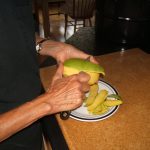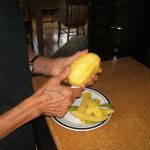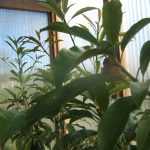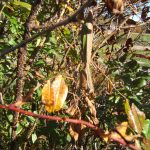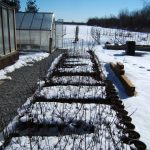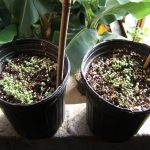Tomatoes
Fall Garden Update
Garden update, with lots of photos!
Well nearly the end of February, everyone is going through their catalogues and wish list’s, trying to match them up. What a marvelous time of year. If your house and/or greenhouse have Citrus then like us, you are suffering with the heavy scent of blossoms wafting through the air. Do not forget to pollinate around midday, an artists brush gently stroked over anthers and stigmas does the trick nicely. Your reward will be fruit in July-Nov. Any not in bud will usually come into blossom April-May.
In about 3-4 weeks we will be able to start spring pruning and tidying up. Our first seeds are sown and germinated, Strawberries need an early start to blossom and fruit by June. Next will be Leeks, Onions then Lettuce, and Tomatoes followed by Broccoli at the end of March.
Weather forecast is still typical for the time of year, although we are down on total precipitation for January and so far through February.
Only a few weeks left to order from our Pine Island plant offering. We already have a couple of orders, and look forward over the next three weeks helping to put clients wishes into reality.
Garden Update July 22, 2018
As the pictures show the first round of garden crops are over. Happy to say we have enough Peas, Broccoli, Yellow and Green beans for the next 12 months in the freezer. With the excess going to friends and neighbours over the last three weeks. Greenhouse Cucumbers and Tomatoes are in full swing, with the garden crop catching up fast.
Just sowed the 2nd crop of Cucumbers for the greenhouse. 2nd crop of garden beans, both Yellow & green came through after only three days. Peas though are struggling with the soil temperature being 27’C. We use the old Pea haulm to shade, cool and help keep moist the newly sown row of peas, but with air temperature this year daily over 30’C not working so well.
Finally overnight our 23 days without any measurable rain has come to an end, .46″ with more as I am writing this. If we get an inch plus then I will get a break from garden watering.
Hard fruit that managed to set, are starting to swell and the rain should help swell the fall raspberry crop. Blueberries are ripening well as are strawberries. Will have to watch the Melons in case they split with the sudden drenching.
We have full season crops of Leek, Carrot and two rows of Potatoes, plus 5 Pole Bean columns in the main garden patch. Which for everyone’s info is 26′ x 26′.
Happy Harvests.
May 28, 2018 Update
So May almost gone, what a contrast with 2017. By the 27th May last year we had had 6″ of rain in May, so far this year less than 2″ with temperature today of 33’C. So yes, we have been watering to help the germination in the veg garden. So far so good, but with not much rain in the forecast the watering hose will be a much used piece of equipment. We use water from 3,000 gal rain water tanks.
We have been growing Ficus for quite a few years, this winter most of the varieties we had in the ‘cold’ greenhouse are not showing signs of growing. In the garden however eight of the eleven types are showing new buds, will keep a watch on the last three over the next two weeks. They are; Chicago Hardy, Yellow Long Neck and Little Ruby.
Most of the blossoming is now over, the next couple of weeks will show how much the wet and cool (at night) start to May has affected the setting of fruits. The most obvious thing missing this spring are Honey Bees. We have a medium sized Lilac in the front garden, by this time of year it is covered with Bees drinking in the nectar. Most days we can count the number of Bees in just a few seconds, when you have local Apiaries around as we have, this is not a good sign. We do have Mason Bees in the garden though, without honey Bees weather is very critical as shear numbers do matter in spring.
As Blossom time is mostly over, we have started our caterpillar (BTK as spray) and mite control (Neoseiulus Fallacis) in the orchard. Also Praying Mantis, Ladybug (both general predators), Lindorus Lophanthae (scale predator) and Delphastus Catalinae (white fly).
Harvesting from the cold greenhouse has started, Radish, Lettuce and Tomato. Sowing Radish and Lettuce every two weeks now until September.
Next garden sowings will be after the Broccoli is harvested, that will be third Pea crop and late Carrots. Second earthing up of Potatoes will be this week. Will be placing supports for climbing Beans this week. Planting out herbs that were earlier sown in pots.
Will know which trees in the orchard have not survived our last winter by mid June. We seem to have lost Apple, Apricot and Peach varieties. New plantings are mostly doing well, we have a couple of plants in pots due to poor spring growth. Just part of gardening and growing.
Spring Is Here!
Well as the picture’s show, Spring is trying to warm and awaken the garden. Just what we have been waiting for the last few months. Do not forget though, that along with Natures bounty comes Natures other summer visitors. Yes, all those little feeders we would rather not see again. Whether, in the past chemically or in our new normal of using nature to control these visitors, you will never be 100% free of them.
We start early in the Fall, with a good clean up of any disease or insects that we see. Making a note of those areas, we watch in Spring for ‘outbreaks’, so they can be looked after quickly. We combine our visual efforts with Biological Beneficial Insects. The following is what we use:
- On all our fruit trees – (in May) Neoseiulus Fallacis (best overall Mite predator).
- General release – (in May) We release Ladybugs Hippodamia convergens in the greenhouse so they travel in and out with the plants, depending on weather, and they then spread out to look after the whole garden.
- For Whitefly control, Delphastus Catalinae, a small black beetle.
- For Scale control, Lindorus Lophanthae, a slightly bigger small black beetle.
- For Caterpillar control, two different modes of action; first, Praying Mantis ( will eat anything it can catch), and second, Safer’s BTK, which is a fungus that infests Caterpillars and therefore kills them.
As you can see, Natures way is mainly to employ ‘flying’ controls, but it’s not everyone’s ideal to have them inside the house. Natural predators will always arrive, but not until their feast is well established. This is because mum likes to lay her eggs in an area which has an ample food supply to nourish her young to adulthood to start the cycle again. When we check our plants weekly, we always have a cloth that has been either soaked in a simple water:dish-soap/200:1 solution or rubbing alcohol and water. When you spot the first visitor, a quick wipe and inspection of the leafs’ top surface, underside, and stem, removing any thing you find, will minimize the issues ahead. If you find a sticky area on a leaf surface, this is an indicator that somewhere above there are feasters enjoying your bounty. Do not wait, treat area straight away!
Having plants outside during the Summer (in an appropriate location), will let Nature do her thing. Ants, although not themselves a pest to worry about, can and do make ‘nests’ in large containers. If you have a nice lush specimen growing in this container and it is free of pests, do not be surprised if the local colony moves a few insect ‘stock’ into this location. They feed on the sugary excretion known as ‘Honey Dew’, which is a byproduct of the feeding insects. They can have their ‘nest’ anywhere within there farming area, so keep an eye out for ant runs.
We use ventilation where possible, and pot or base watering to avoid mould and mildew. When it is frosty outside and ventilation not always practical we use Green Earth Bordo mixture. Never leave a plant standing in water unless it is a water plant. Drowning should never be an issue for plants, so make sure excess water can drain away. Going away for a time, and leaving a plant in a saucer can sound like a good idea for a couple of days. But place somewhere where it will not be rained on while you are away. You do not need to keep in filled up. A shady spot, sheltered from heavy rain is best.
At this time indoor seed sowing should be well underway. Most Peppers, Herbs, Onion, Leek and Tomato should be nicely through. First Broccoli next week then more Lettuce, Garden Tomato varieties, Greenhouse Cucumbers and Radish.
Week 9 Garden Update
Tomato Defiant (in Photo) plants are cuttings from last years plant. The stump had thrown up these two shoots, so we decided to root them. This works with all types of tomatoes. Take shoots that are not truss shoots from lower down the plant during season. Root them for a late crop. If it’s a damp, cool year, only use those varieties that are resistant to early and late blight. We have found Defiant works well in the garden or in a protected environment.
Also sown this week: Tomatoes Cobra for greenhouse; we keep to single stem, Mountain Magic for outside, Mountain Merit for outside and Siderno for pots. Lettuce Larissa, (short day type) therefore winter season only. Grow cool under short days or will bolt.
When you buy your seed, there is always more than you need at any one time. If you need 4 plants and have 2 varieties, then sow no more than 3 of each. Pick the best two and discard the third (or give to friend). When sown, roll end of packet over and place in a plastic lunch bag (with all other left over seed), seal and place in your fridge door. Do not freeze seed, as this can lead to desiccation. We have kept seed up to 10 years with little fall off in germination %.
February brought us 1/3rd more moisture than average, so the garden is up to capacity. Itching now to start getting the ground prepared for first outdoor sowing’s.
2018 Sow Sheet
Want to know what’s going into our garden this year? Check out our 2018 Sow Sheet!
Garden update

Summer harvest now well underway; Tomatoes, Cucumber, Lettuce, Peas, Beetroot, Celery, Lemons, Oranges, Rhubarb, Strawberries, Broccoli, Carrot, Radish, Raspberries (Red, Gold, Black), Haskap, Onions.
End of June finishes the heartbreak of June drop. Quite a lot this year, with Plum and Apricot almost totally gone. Apples, Pears and Quince first crop in third year of our orchard. The Niagara grape (wrongly named) as usual, even with preventative spraying, succumbed to mildew. Had enough, so plants will have been removed.
Maybe July will bring old fashioned stable weather, i.e. hot during the week and rainy on weekends. We have only had just over 1.1″ of rain during June. Only .03″ – .05″ per night, non during the day. Yes, just enough to keep the foliage damp, but not enough to water the soil. Yes, we have rain barrels (2600 gals), so we’re able to provide the plants with enough to grow.
Week III

A couple of brighter days and the garden is in! The tomatoe plants started in the cold greenhouse really shot up (4’+) with a few warmer days. Fruit set looks quite good. Apples now coming into their own with 21 of 42 varieties in pink bud/blossom. All fruit trees have had a first spray with BT, four days after an application of field mite preventor – Neoseiulus Fallacis. This is a native type, so will establish over time.
We now have Red & Black Currants, Gooseberries, Apricots, Plums, and Haskaps set. Pears we will know in about 2-3 weeks. Peas, Beans, Beetroot, and Potatoes are emerging from the still cool, damp soil. Celery, Leeks and Onions rooting out nicely. Early Broccoli showing signs of Curd formation. Nearly finished the ‘pot’ grown Radish, Carrots, Peas, Onions, Lettuce, Cucumber and Tomatoes. Just need the weather to stay warm and watch the garden spring to life!



















